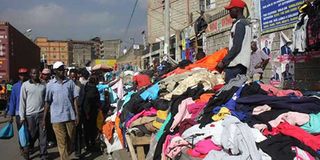Overcrowded, littered and neglected, Gikomba a perennial tinderbox

Traders at Gikomba market in Nairobi. Experts say the market’s very nature: stalls constructed out of timber and paper, haphazard electric connections, accumulation of rubbish, and overcrowding are directly to blame for frequent fires. PHOTO | FILE | NATION MEDIA GROUP
What you need to know:
- Cars which use these roads are forced to go at a snail’s pace and to hoot constantly to scatter away people in the way.
- Rubbish competes for space with goods for sale, accumulating due to poor waste management.
- Other recommendations include having central points for storing generators and fuel.
It is no surprise that Gikomba has become a perennial tinderbox.
Experts say the market’s very nature: stalls constructed out of timber and paper, haphazard electric connections, accumulation of rubbish, and overcrowding are directly to blame for frequent fires.
“Fire spreads quickly in overcrowded spaces, where potential fuel in the form of timber, rags and paper is in plenty and where no fire-fighting equipment exists. And that is Gikomba in a nutshell,” says Mr Joshua Kivuva, a safety trainer at Kenya Fire Appliances Ltd.
Indeed, a visit to Gikomba is a test of grit and resilience.
CROWDED
The stalls are crowded so close together that one cannot tell where one ends and the next one begins.
Failing to find stalls, other traders display their wares in heaps on the ground on what are sup-posed to be roads and paths, forcing shoppers to hop, step and jump over mounds of clothes in order to move from one part of the market to the other.
Cars which use these roads are forced to go at a snail’s pace and to hoot constantly to scatter away people in the way.
Rubbish competes for space with goods for sale, accumulating due to poor waste management.
It is chaotic and messy, a testament to government neglect despite the billions of shillings generated by sale of second-hand clothes alone in this market every year.
POOR PLANNING
“Gikomba’s biggest problem is its lack of proper planning. Where proper roads exists, they have been encroached on by hawkers, making it difficult for fire engines to access the area in case of a fire. ” said Mr Kivuva.
Away from the stalls, storied buildings which residents call home are as crowded as the market, and have neither emergency exists nor fire extinguishers, as is required by law.
This oversight, Mr Kivuva said, is a big contributor to the number of fatalities and injuries that occurred in the blaze.
EMERGENCY EXITS
“Emergency exits provide a quick and easy escape route for people in a burning building,” he said.
A study on open air markets in Nigeria found that the most common causes of fires are storage, electrical installations, poor disposal of waste, poor regulation, and inadequate awareness and fire emergency plans.
The study came up with various measures to prevent fires: Proper ventilation of shops, fire walls, limitations to high rise buildings, and wiring to be done in conduits, not on the surface.
Other recommendations include having central points for storing generators and fuel, proper firefighting tools, dedicated space for cigarette smoking and dedicated spaces for parking cars and loading bays.




